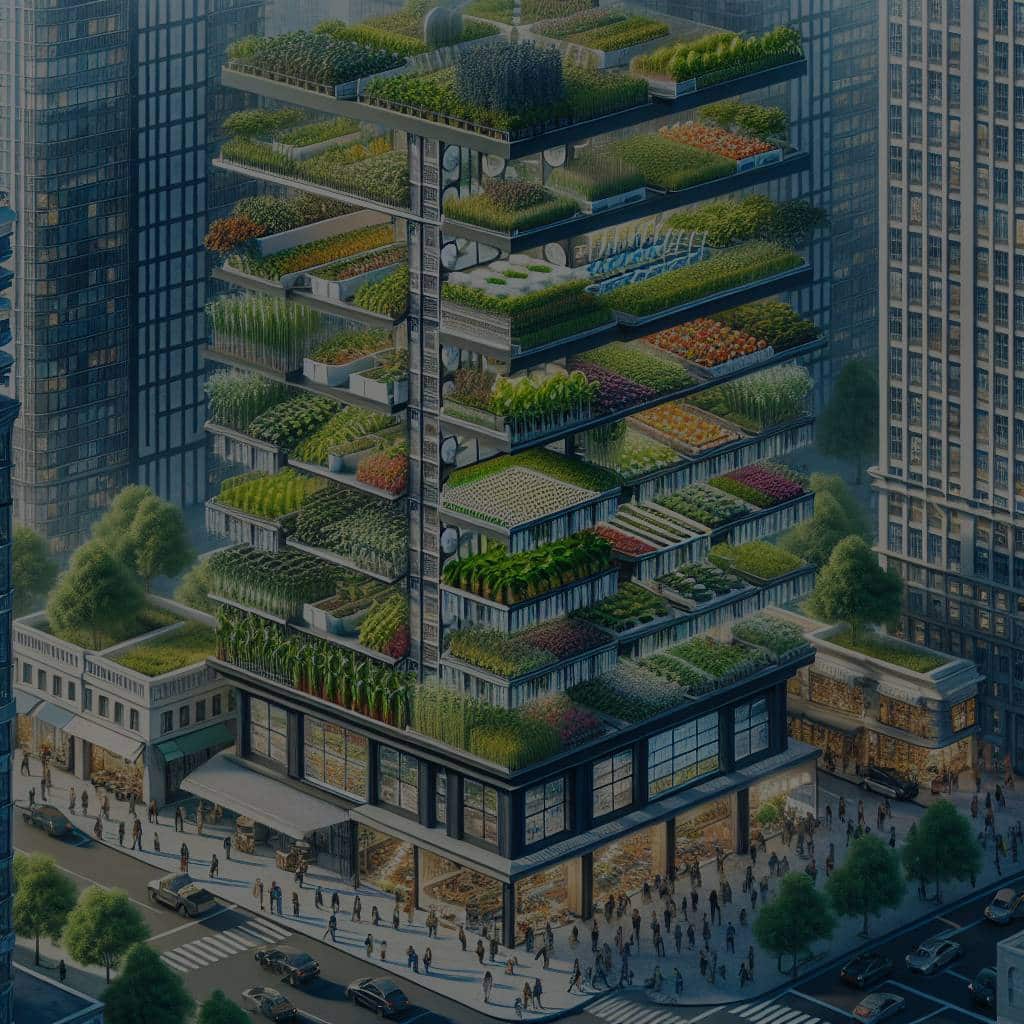Today, food production faces significant challenges due to growing urbanization, increased land and water usage, and mounting environmental concerns. One innovative solution that has emerged is vertical farming. This method of agriculture leverages vertical space to produce food in urban environments, often within the confines of a city’s skyscrapers or residential buildings. But, can vertical farming really be integrated into urban residential developments? Let’s explore this intriguing possibility and its implications for sustainable food production.
The Concept of Vertical Farming
The towering cities with their sprawling suburbs are the hubs of human activity today. Amidst the concrete jungles, the concept of vertical farming rises, promising a sustainable solution to food production challenges. This innovative farming technique utilizes vertical layers and hydroponic systems to cultivate crops, exploiting city spaces that are typically underutilized.
Additional reading : How to Develop a Real Estate Investment Strategy Around University Expansion Plans?
Vertical farming is a form of controlled environment agriculture (CEA), where plants are grown in stacked layers. It uses artificial lighting and climate control to create the optimal conditions for plants to thrive. This farming method offers a host of benefits including year-round crop production, reduced land use, conservation of resources, and elimination of the need for pesticides or fertilizers.
Integration of Vertical Farming into Urban Developments
Urban residential developments have long been detached from the agricultural sector. But with the advent of vertical farming, this dynamic is shifting. Residential buildings and skyscrapers can now be utilized to cultivate fresh produce right where people live.
In parallel : What Are the Trends in Smart Home Technology Adoption for Real Estate Development?
By converting rooftops, balconies, or entire floors into vertical farms, urban buildings can serve dual purposes: housing and food production. Vertical farming systems can be integrated into the architectural design of new buildings or retrofitted into existing ones. The integration of vertical farming into urban residential developments has the potential to drastically reduce the distance that food travels from farm to plate, leading to a decrease in food transportation costs and associated carbon emissions.
The Environmental Impacts of Vertical Farming
One of the most promising aspects of vertical farming is its potential to reduce the environmental footprint of agriculture. Traditional farming methods are notoriously resource-intensive, requiring vast amounts of land, water, and energy. Vertical farming, on the other hand, offers a more sustainable alternative.
Vertical farms use up to 95% less water than traditional farms, as irrigation is carefully controlled and water is recirculated. They also require significantly less land, as crops are stacked in vertical layers. Furthermore, the controlled environment of a vertical farm reduces the need for pesticides and fertilizers, leading to cleaner produce and reduced chemical runoff.
Challenges in Implementing Vertical Farming
Despite the numerous benefits, vertical farming is not without its challenges. The initial setup costs of vertical farms can be high, with significant expenses related to the installation of growing systems, lighting, and climate control technologies. Energy consumption is another concern, as vertical farms rely heavily on artificial lighting, which can lead to high electricity bills.
As with any emerging technology, there’s a learning curve associated with vertical farming. Farmers need to master new techniques and technologies, and larger operations may require skilled labor to manage the systems. Also, not all crops are suitable for vertical farming. While leafy greens, herbs, and some fruits can be grown vertically, staple crops like wheat and corn are not yet viable in vertical systems.
The Future of Vertical Farming in Urban Developments
As cities continue to grow and the demand for locally sourced, sustainable produce increases, vertical farming presents a promising solution. While there are challenges to overcome, the potential benefits of integrating vertical farms into urban residential developments are significant.
The integration of vertical farming into urban residential developments is still in its early stages, but already, we are seeing promising examples around the world. From rooftop farms in New York to high-tech indoor farms in Tokyo, these pioneering projects showcase the potential of vertical farming to revolutionize urban agriculture and transform our cities into sustainable food production centers.
As we look to the future, it is clear that vertical farming will play a crucial role in meeting our food production needs. The integration of vertical farms into urban residential developments is not just a possibility – it’s an imperative. By embracing this innovative approach, we have the opportunity to create more sustainable cities, conserve our resources, and ensure the availability of fresh, local produce for urban populations.
While the journey to widespread adoption of vertical farming in urban settings is still underway, the potential is undeniable. With continued research, technological advances, and investments, vertical farming will undoubtedly become a common feature of our urban landscapes, transforming the way we think about agriculture and our cities.
Harnessing Technology for Vertical Farming
With the rise of smart cities, technology is playing an increasingly central role in urban planning, and this extends to urban agriculture as well. Vertical farming, being a technologically advanced farming method, leverages various tools and techniques to enable controlled environment agriculture in urban areas.
A vertical farm operates through a combination of hydroponics or aeroponics, LED lighting, and climate control systems. Hydroponics involves growing plants in nutrient-rich water instead of soil, while aeroponics grows them in an air or mist environment. These techniques, combined with optimal light and temperature conditions, enable year-round production of fresh produce.
One key advantage of these technologies is that they are continually improving. For example, energy-efficient LED lights can now mimic the full spectrum of sunlight, supporting all stages of plant growth. Automated systems control factors such as temperature, humidity, and light intensity, ensuring optimal farming conditions while minimizing manual labor.
However, the reliance on technology also presents challenges. Farming traditionally is a skill passed down through generations, but vertical farming requires a new skill set, including knowledge of sophisticated technological systems. As such, there’s a need for training and education to enable farmers to effectively manage these high-tech urban farms.
The role of technology in vertical farming also raises questions about accessibility. While some companies, like Sky Greens, have made strides in making vertical farming systems more affordable, the high initial investment and operation costs can still be a barrier for many. Addressing this concern is crucial to making vertical farming a viable solution for urban food production.
Vertical Farming and Urban Sustainability
Climate change and sustainability are critical considerations in urban development, and vertical farming presents an opportunity to address these issues. By localizing food production, vertical farms can significantly reduce the carbon footprint associated with transporting food from rural farms to urban markets.
Moreover, vertical farms can contribute to food security by providing fresh produce year-round, independent of weather conditions or seasons. This can be particularly beneficial in urban areas that experience harsh climates or have limited access to arable land.
Vertical farming also aligns with the principles of circular economy. The ability to recycle water and nutrients within the system reduces waste and promotes resource efficiency. Additionally, some vertical farms have started to harness renewable energy sources, further reducing their environmental impact.
However, it’s important to note that while vertical farming has considerable potential to contribute to sustainable urban development, it’s not a standalone solution. It needs to be integrated into a broader framework of sustainable practices to truly make a difference.
Conclusion: The Future of Vertical Farming and Urban Living
The integration of vertical farming into urban residential developments holds significant promise for sustainable food production. While challenges exist, such as high initial costs and the need for technological proficiency, the potential benefits are substantial.
As cities continue to expand and the effects of climate change intensify, the need for localized, sustainable food production methods like vertical farming will only grow. With continued research and innovation, vertical farms could become a common feature in our urban landscapes, contributing to food security, environmental sustainability, and the overall quality of urban living.
Innovative approaches, such as vertical farming, are crucial as we navigate the challenges of urbanization and climate change. By harnessing technology and embracing sustainable practices, we can transform our urban areas into thriving, green communities. From a Google Scholar perspective, numerous researches support the potential of vertical farming in contributing to sustainable urban development.
The journey towards widespread adoption of vertical farming is still in progress, but the momentum is building. It’s not just about growing food; it’s about cultivating a sustainable future for all. And in this future, vertical farming stands tall as a promising solution.











